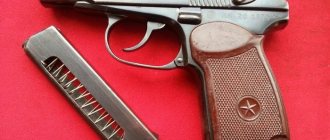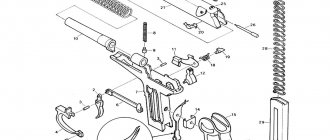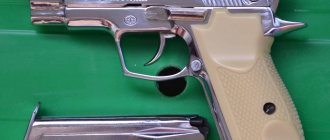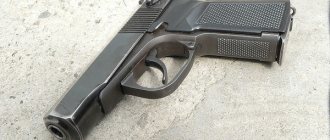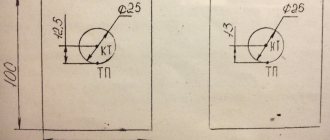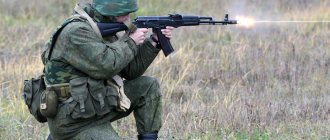Barrel of Makarov pistol "PM"
Inside it has a rifled channel with four grooves and a chamber. Chamber with a ledge. The outer surface is smooth. On the breech there is a boss for attaching the barrel to the frame post and a hole for the frame pin. At the bottom of the tide there is a bevel for directing the cartridge from the magazine to the chamber. The barrel is firmly secured to the frame post with a tight fit and a pin.
Parts of the PM pistol. 1
—
casing-shutter;
2 -
ejector;
3 —
pressure with a spring;
4 —
rear sight;
5 -
drummer;
6 - fuse with spring; 7 -
shutter stop;
8 —
return spring;
9 —
sear with a spring;
10 -
trigger;
11 —
trigger rod with cocking lever;
12 —
frame;
13 -
trunk;
14 —
trigger guard;
15 —
trigger with an axis;
16 —
trigger spring;
17 —
mainspring;
18 —
handle: 19
—
handle screw; 20 - store
History of creation
At the end of the Great Patriotic War, the commission of the Main Artillery Directorate recognized the Nagan revolvers of 1895, which were obsolete by that time, and the Tokarev self-loading pistol as not meeting the requirements of reliability and combat effectiveness. In 1948, a competition was announced between design bureaus to present a reliable general-arms service pistol.
Expert
Stepanov Maxim Sergeevich
Honored Master of Sports in Bullet Shooting
Ask a Question
The ISSF discipline is rifle shooting at a moving target. 25-time world champion (5 in individual competition, 20 in team competition). Mechanic of the 4th category for the repair of civilian and service weapons (School of Gunsmithing named after Leonard Vasev).
After conducting tests, the selection committee selected the PM pistol, designed by Makarov Nikolai Fedorovich Makarov, as the most suitable option among the presented samples. PM entered service in 1951.
Shutter cover of the Makarov "PM" pistol
It is a combination of two parts into one whole: the barrel casing and the bolt itself. This has a positive effect on automatics with blowback recoil, as it increases the weight of the bolt. The bolt casing has a transverse groove on the outside for the movable rear sight, a notch to eliminate glare when aiming, a window for ejecting spent cartridges, a groove for the ejector and a socket for its spring, a socket for the fuse and recesses for its fixation, a notch for ease of retracting the bolt to the rear position , groove for the trigger. Inside, the bolt casing has a channel for the barrel, longitudinal projections for moving the bolt casing along the frame, a groove for the reflector, a groove for the release protrusion of the cocking lever, a cartridge rammer into the chamber, a cup for placing the bottom of the cartridge case, a protrusion for separating the cocking lever from the sear, a recess for placing the release ledge of the cocking lever when the trigger is pressed, a channel for placing the firing pin.
Makarov pistol frame "PM"
It is integral with the base of the pistol handle and has a stand with a hole for attaching the barrel, a window for placing the trigger head and a curved groove for placing the trigger rod; trunnion sockets for placing trigger trunnions; projections with trunnion sockets for trigger and sear trunnions; grooves for directing the movement of the shutter; window for mainspring feathers; window for the top of the store; cutout for slide stop. The base of the handle has side windows to lighten the weight, a window for inserting a magazine, a boss for attaching the mainspring and handle, a cutout for the magazine latch, and a boss with sockets for attaching the trigger guard. The trigger guard has a ridge at the front end to limit rearward movement of the bolt. In the frame, it is held in the upper position by an eyelet and a bend located on the front wall of the base of the handle. The handle with the screw is a kind of plastic U-shaped shield that covers the side windows of the base of the handle.
Shutter cover of the Makarov "PM" pistol: 1 - front sight; 2 - rear sight; 3 — window for ejecting the cartridge case; 4 - fuse socket; 5 - notch; b - channel for placing a barrel with a return spring; 7 - longitudinal projections to guide the movement of the shutter along the frame; 8 — tooth for setting the bolt to the bolt stop; 9 — grooves for the reflector; 10 — groove for the release protrusion of the cocking lever; 11 — recess for disconnecting the sear from the shutter lever; 12 - rammer; 13 — protrusion for separating the cocking lever from the sear; 14 — recess for placing the release protrusion of the cocking lever; 15 — groove for the trigger; 16 - comb
Frame with barrel and trigger guard of the Makarov "PM" pistol: 1 - base of the handle; 2— trunk; 3 — stand for attaching the barrel; 4 — window for placing the trigger and the ridge of the trigger guard; 5 — sockets for trigger pins; b - curved groove for placement and movement of the front axle of the trigger rod; 7 — sockets for trigger and sear journals; 8 - grooves for directing the movement of the shutter; 9 — window for mainspring feathers; 10 — cutout for the bolt stop; 11 — boss with a threaded hole for attaching the handle and mainspring; 12 — cutout for magazine latch; 13 — boss with a socket for attaching the trigger guard; 14 — side windows; 15 — trigger guard; 16 - ridge to limit the movement of the shutter back; 17 - window for exiting the upper part of the store
Modifications based on PMM
The modernized Makarov pistol is produced in two main combat versions - PMM 8 and 12, differing in the type and capacity of the magazine. Based on the PMM 12 pistol, a sports version of the IZH-70-100 (or 70-17A) is produced chambered for a regular cartridge, equipped with an adjustable sight and a 12-round magazine.
For export supplies, Baikal 442 is manufactured, equipped with a barrel with 6 rifling and clips for 8, 10 or 12 standard cartridges. Since the fall of 2015, this version of the pistol has received a certificate for sale on the Russian market.
For service purposes, the IZH-71-100 (or MP-71N since the fall of 2008) is supplied, using weakened 9 * 17K cartridges. Such pistols are equipped with only 10-round clips.
Trigger mechanism of the Makarov "PM" pistol
It consists of: drummer; trigger; action spring; sear with a spring; trigger; trigger rod with cocking lever. The firing pin has a firing pin in the front, and a cut for the fuse in the rear, which holds the firing pin in the bolt channel.
Striker of the Makarov "PM" pistol:
1 —
striker;
2 -
cut for fuse.
Trigger of the Makarov "PM" pistol: 1 - head with a notch; 2 — recess for catching the fuse; 3 - safety platoon: 4 - combat platoon; 5 — self-cocking tooth; b - recess for the mainspring; 7 — left trunnion.
Mainspring of the Makarov "PM" pistol: 1 - wide feather; 2 - narrow feather; 3 - hole; 4 - lower end (magazine latch).
The trigger is a part of a very complex configuration. It has a head with a notch for cocking the hammer by hand, a cutout for free movement of the hammer when releasing it from combat cocking, a recess for hooking the safety, a safety ledge, a combat cocking ledge, pins on the sides for rotating the hammer, arcuate grooves to reduce weight, a self-cocking tooth for cocking the hammer with the cocking lever, a protrusion for locking the hammer with the cocking lever, a protrusion for locking the hammer with a fuse, a recess for the wide feather of the mainspring, an annular recess for the heel of the cocking lever. The mainspring is a complex-shaped, double-leaf spring. It has a wide feather for acting on the trigger, a narrow feather for acting on the cocking lever and trigger rod, and a hole for putting on the base of the handle. The lower end of the mainspring is the magazine latch. The bend of the wide feather provides a “release” of the trigger. The sear has a spout for engagement with the trigger ledges, trunnions for rotation, a tooth for raising the sear with a safety catch, and a protrusion that fits into the cutout of the cocking lever when the trigger is released. A spring is attached to the left trunnion of the sear, the protrusion of which is connected to the bolt stop. The trigger has pins for rotation, a hole for connecting to the trigger rod and a tail for applying force when firing. The trigger rod with the cocking lever has pins at the ends. The front pin connects to the trigger, and the rear pin connects to the cocking lever. The cocking lever works in conjunction with the trigger rod and has a protrusion for disengaging from the sear when the bolt moves backward, a cutout for the protrusion of the sear, a self-cocking protrusion, and a heel for resting the narrow feather of the mainspring.
Trigger of the Makarov "PM" pistol: 1 - right trunnion; 2 — hole for connection with the trigger rod; 3 - tail.
Trigger rod with cocking lever for the Makarov "PM" pistol: 1 - trigger rod; 2 - axles; 3 - disconnecting protrusion; 4 — cutout for the sear protrusion; 5 — self-cocking protrusion; b - heel for the narrow feather of the mainspring.
Ballistic characteristics of the cartridge
The bullet flies at a speed of 350 meters per second and this is an excellent indicator. If we take into account the class of ammunition, then this type of equipment has one of the best sets of characteristics. A regular PM cartridge easily penetrates wooden structures and thin metal sheets. If you fire shots at a steel sheet or concrete wall, the charge will be destroyed upon impact with such a hard surface. For such a case, there are armor-piercing cartridges of this class. Basic charge indicators:
| Characteristic | Parameter |
| Caliber | 9 mm |
| Cartridge weight | 10 g |
| Charge mass | Circumference – 0.25 g |
| Bullet weight | 6.1 g |
| Chuck length | 25 mm |
| Bullet length | 12.35 mm |
| Case length | 18.1 mm |
| Loading chamber volume | 0.56 cm3 |
| Maximum gas pressure | 118 MPa (1200 kg/cm2) |
| Bullet speed V10, m/s | From 290 to 435 |
| Specific energy, J/mm2 | From 4.2 to 7.2 |
Video “Firing PM bullets through a chronograph”
Conventional PM ammunition, when destroyed, can produce multiple ricochets. This is due to the fact that the shape of the core inside the bullet is round. This feature of the projectile is the main danger. There is always a risk of people being in close proximity to the rebound area getting hit by a stray bullet. Experts do not recommend using a pistol in a confined space unless the people there are protected by body armor with steel plates.
This ammunition is used in guns for self-defense and shooting training. It can be found both in service weapons and in some variations of trauma weapons. In the latter category, 9mm bullets are one of the most powerful types of self-defense ammunition. Designers have created many variations of 9x18 mm PM. They differ from each other not only in their design and technical characteristics, but also in the type of damage. Most often, these shells are used on domestic small arms, such as the Makarov and Stechkin. Sometimes these bullets are used by military personnel because the 9mm cartridges are ideal for the silent PB and APB models.
Despite the low penetration power, the PM cartridge is considered a universal ammunition that will not lose its relevance for a long time.
The mechanism for feeding cartridges into the chamber of the Makarov pistol "PM"
The cartridges are fed into the chamber by the lower part of the bolt, which is called the rammer. The supply for loading cartridges is provided by the magazine using a feeder and a feeder spring. This also includes the shutter lag. The magazine consists of a body, a feeder, a magazine cover, and a feeder spring. The magazine body is a box, the upper edges of the side walls of which are bent inward to hold the cartridges and feeder. At the bottom there are curved ribs for the lid, on the sides there are windows for control. The feeder has two bent ends to guide movement. One has a hook for engaging the slide stop. The feeder spring is a coiled spring of figured manufacture. One end of it serves to lock the lid. The magazine cover has hooks and a hole for a latch. The bolt stop has a protrusion for holding the bolt in the rear position, a button with a notch for the hand, a hole for connecting to the sear pins, a tooth for disabling the bolt stop with a magazine, and a reflector.
Return spring of the Makarov PM pistol.
Ejector with a bend and a spring for a Makarov pistol "PM": 1 - hook; 2
—
heel
Makarov pistol magazine "PM":
I - magazine body;
2 —
figured windows;
3 -
curved ribs;
4 — protrusion for magazine latch; 5 — oblique protrusion for turning off the shutter stop; 6 —
feeder;
-
hook for turning on the bolt stop;
8 —
magazine cover;
9 —
feeder spring.
Bolt stop of the Makarov "PM" pistol:
I - protrusion for holding the bolt;
2 —
button with a notch;
3 —
hole for connecting to the sear pins;
4 -
tooth for turning off the bolt stop with a magazine;
5 -
reflector.
Makarov pistol safety "PM": 1
—
a spring to hold the fuse in the required position;
2 —
hook for locking the trigger;
3 -
protrusion for blocking the trigger when the safety is turned on;
4 -
a ledge with a break for turning the sear and releasing the hammer when the safety is turned on.
Various variations and modifications
In the USSR, there were no sports or other versions based on the PM. The only attempt to modify the pistol were prototypes of weapons with a frame made of polymer materials. Such work was carried out at the very beginning of the 60s at the Instrument Design Bureau in the city of Tula. The results obtained during the tests did not satisfy the customer, and the experiments were not continued.
The situation changed dramatically at the very beginning of the 90s, when dozens of variants of Makarov sports, gas and air pistols chambered for cartridges of various calibers were produced on the basis of PM and PMM.
The most common was the IZH-70, designed for a standard cartridge and a .380ACP cartridge and equipped with an 8-round magazine.
It exists in several versions:
- IZH-70-17A and 18A, chambered for 380ASR and PM cartridges, respectively, with adjustable sight parts.
- IZH-70-17AS and 18AS, with chrome-plated outer surface.
- IZH-70-17AN and 18AN, commercial version of the pistol.
In addition to these options, multiple variations of the pistol were produced for the use of gas and traumatic cartridges. The most popular were 9 mm 6P42-9 and 7.6 mm 6P42-7.6. These variants are combat versions of weapons with a pin installed in the barrel, which does not allow the use of real cartridges.
Exactly the same design is the 6P42 (or IZH-79-8), developed for the use of 8 mm gas cartridges.
In the early 2000s, the IZH-79-9T (or a similar MP-79-9, which provided the ability to fire a rubber bullet using a special 9-mm RA gas cartridge) became popular. The ZID plant produced a pistol in a limited batch of several thousand pieces PM T.
All of these options were made on the basis of real weapons and were equipped with a partition in the barrel bore.
For official use, the MP-471 is used, developed for the use of a 10*23 mm traumatic cartridge and has been mass-produced since 2004.
A variant version is the MP-80-13T, which uses .45 Rubber cartridges as ammunition. The signal version of the pistol under the symbol MP-371, which is similar in appearance to the Makarych, deserves special mention. The ammunition used for it is “Zhevelo” or KV21 type capsules.
Safety devices of the Makarov pistol "PM"
As mentioned above, protection from an accidental shot is carried out in three ways: “release” of the trigger - due to the wide feather of the mainspring; using a safety platoon; using a mechanical safety catch. The fuse is held in a given position by its spring and has a flag for switching from the “fire” position to the “safety” position and back; an axis with a ledge for turning the sear and releasing the hammer from cocking when switched to the “safety” position; a rib that ensures the closure of the shutter with the frame in the “safety” position; hook for locking the trigger in the “safety” position; a protrusion to absorb the impact of the trigger when the safety is turned on. As you can see, this small part is multifunctional in purpose and connections with other parts and is technologically complex.
Disadvantages of the model
One of the major disadvantages of the weapon is the high tendency of standard bullets to ricochet off any hard surface. This drawback was partly corrected by the creation of new types of cartridges for the Makarov pistol. Another disadvantage of the design is that the center of gravity of the PM is slightly shifted towards the barrel, which leads to fatigue in the shooter’s hand during prolonged firing.
But after 10-15 shots this drawback is not noticed.
The declared warranty life of the weapon does not exceed 5 thousand shots. However, there are many examples of pistols with rounds much greater than the warranty. At the same time, they remain in completely good condition. On the classic PM, the magazine capacity is insufficient; this flaw was partly eliminated on modernized versions of the pistol, but 12 rounds is not a good indicator for modern weapons.

